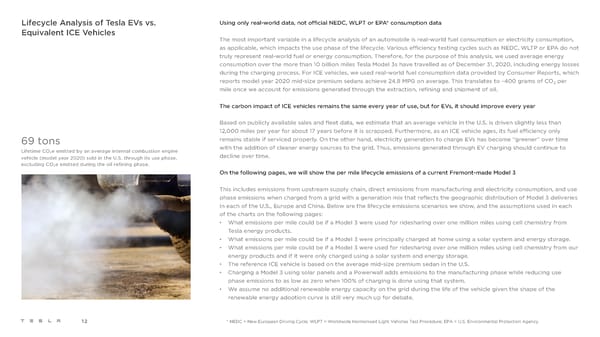Lifecycle Analysis of Tesla EVs vs. Using only real-world data, not official NEDC, WLPT or EPA* consumption data Equivalent ICE Vehicles The most important variable in a lifecycle analysis of an automobile is real-world fuel consumption or electricity consumption, as applicable, which impacts the use phase of the lifecycle. Various efficiency testing cycles such as NEDC, WLTP or EPA do not truly represent real-world fuel or energy consumption. Therefore, for the purpose of this analysis, we used average energy consumption over the more than 10 billion miles Tesla Model 3s have travelled as of December 31, 2020, including energy losses during the charging process. For ICE vehicles, we used real-world fuel consumption data provided by Consumer Reports, which reports model year 2020 mid-size premium sedans achieve 24.8 MPG on average. This translates to ~400 grams of CO per 2 mile once we account for emissions generated through the extraction, refining and shipment of oil. The carbon impact of ICE vehicles remains the same every year of use, but for EVs, it should improve every year Based on publicly available sales and fleet data, we estimate that an average vehicle in the U.S. is driven slightly less than 12,000 miles per year for about 17 years before it is scrapped. Furthermore, as an ICE vehicle ages, its fuel efficiency only 69 tons remains stable if serviced properly. On the other hand, electricity generation to charge EVs has become “greener” over time Lifetime CO e emitted by an average internal combustion engine with the addition of cleaner energy sources to the grid. Thus, emissions generated through EV charging should continue to 2 decline over time. vehicle (model year 2020) sold in the U.S. through its use phase, excluding CO2e emitted during the oil refining phase. On the following pages, we will show the per mile lifecycle emissions of a current Fremont-made Model 3 This includes emissions from upstream supply chain, direct emissions from manufacturing and electricity consumption, and use phase emissions when charged from a grid with a generation mix that reflects the geographic distribution of Model 3 deliveries in each of the U.S., Europe and China. Below are the lifecycle emissions scenarios we show, and the assumptions used in each of the charts on the following pages: • What emissions per mile could be if a Model 3 were used for ridesharing over one million miles using cell chemistry from Tesla energy products. • What emissions per mile could be if a Model 3 were principally charged at home using a solar system and energy storage. • What emissions per mile could be if a Model 3 were used for ridesharing over one million miles using cell chemistry from our energy products and if it were only charged using a solar system and energy storage. • The reference ICE vehicle is based on the average mid-size premium sedan in the U.S. • Charging a Model 3 using solar panels and a Powerwall adds emissions to the manufacturing phase while reducing use phase emissions to as low as zero when 100% of charging is done using that system. • We assume no additional renewable energy capacity on the grid during the life of the vehicle given the shape of the renewable energy adoption curve is still very much up for debate. 12 * NEDC = New European Driving Cycle; WLPT = Worldwide Harmonised Light Vehicles Test Procedure; EPA = U.S. Environmental Protection Agency
 Tesla Impact Report 2020 Page 11 Page 13
Tesla Impact Report 2020 Page 11 Page 13